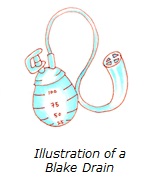What is a Blake Drain?
It is a round, flexible system that can be carried around. It is used for closed wound drainage.

A blake drain is used to drain blood and other fluids from your wound post-surgery. This helps to prevent infection and speed up wound healing. It is inserted by your surgeon during surgery. You can have one to four drains depending on the type of surgery performed.
How Does a Blake Drain Work?
It uses a vacuum system to draw fluids from your operation site into a reservoir bulb. You need to always maintain the vacuum of the bulb in order to facilitate drainage and prevent blockage.
You will be given a Wound Drainage Record Chart upon discharge. Record your drainage amount in this chart when your drainage bottle is half to three-quarter full or there is no vacuum in the bottle.
How Long Do I Need a Blake Drain For?
Your drain usually last between one to two weeks. But it may last longer depending on your drainage amount.
When Should I Empty My Blake Drain?
You should empty your drain three times a day. Once in the morning, once in the afternoon and just before you go to bed. You should also empty the drain when there is no vacuum in the bottle.

| 1. Wash your hands with soap and water. |

| 2. Prepare 70% alcohol swabs, a measuring cup and your Wound Drainage Record Chart. |

| 3. Hold the tubing together with the bottle and flip open the plug from the bulb. |

| 4. Once the bulb is inflated, turn your drain upside down over the measuring cup. |

| 5. Squeeze the drainage bulb gently and empty the content into the measuring cup. |

| 6. Once empty, fold the bulb into half and squeeze all the air out. |

| 7. Close the cap. Clean the emptying port with alcohol swabs. |

| 8. Secure the cap with a tape. Do not dangle the drain and carefully put it back into your pocket. |

| 9. Record the date, time, amount and colour of the fluid in your chart. |

| 10. Flush the fluid into the toilet bowl. Rinse the measuring cup. |

| 11. Wash your hands with soap and water. |
Illustrations courtesy of PSA Chan Yee Wen
What if My Drainage Tubing Slips Out?
If your drain accidentally slips out, your discharge will become milky or cloudy with a foul smell. You may also experience redness or swelling at the operated site. Steps to take:
- Do not panic. Take note of the colour and amount of discharge.
- lean the drain site with alcohol swabs and cover with a gauze. Change the gauze whenever it gets soaked with discharge.
- Call TTSH Breast Clinic and our Breast Care Nurse (BCN) will attend to your queries during office hours. You may seek medical attention at your nearest polyclinic or your family general practitioner clinic after office hours.
What Do I Do if the Drainage Tubing is Blocked or Overflowing?
Please contact TTSH Breast Clinic during office hours. Please seek medical help at your nearest Emergency Department after office hours.
You may feel giddy, breathless or experience chest discomfort if there is a sudden increase in drainage of fresh blood. Please seek medical attention at your nearest Emergency Department immediately.
